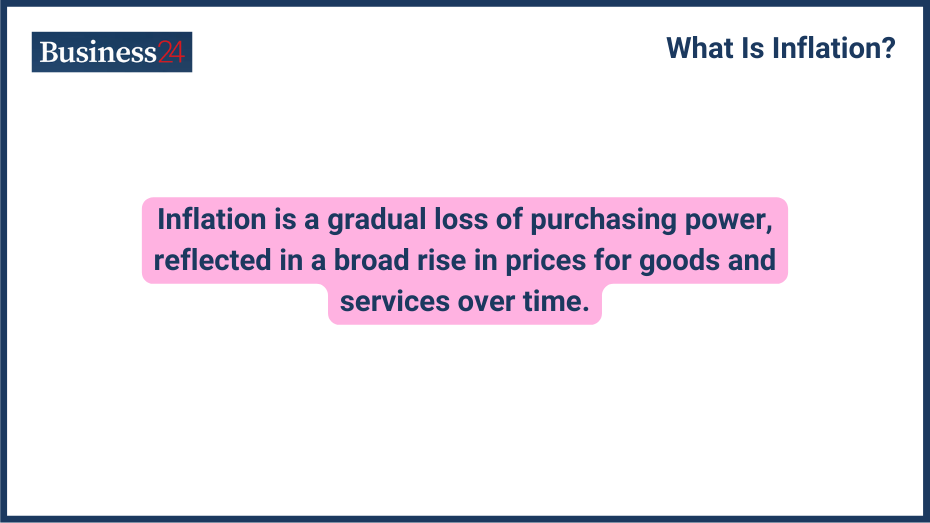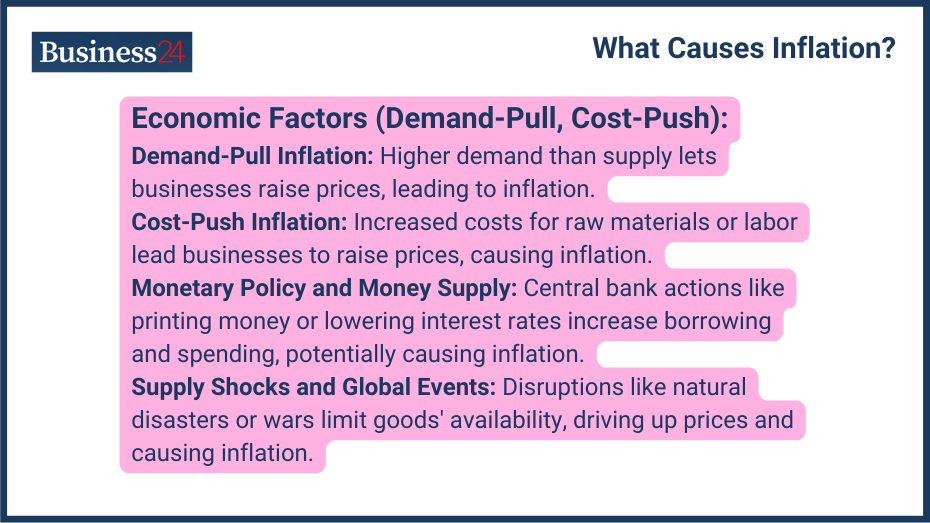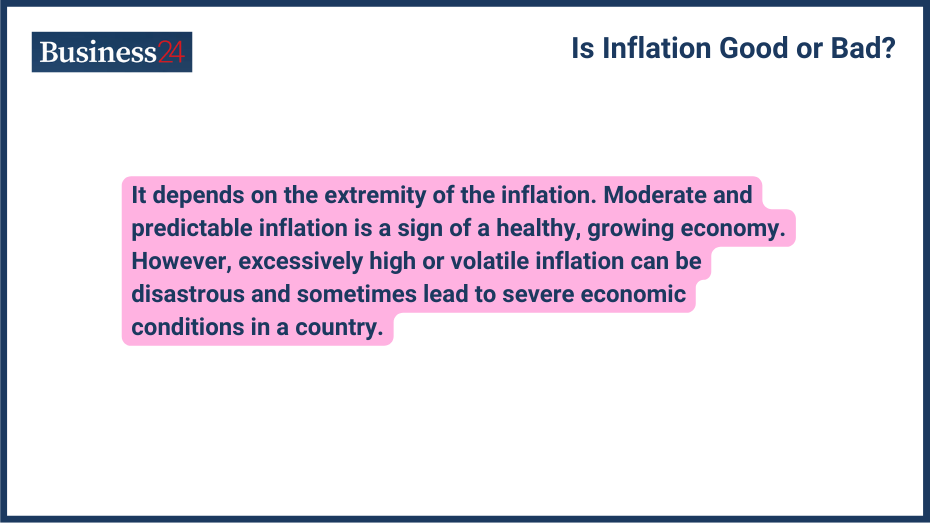
Inflation is a gradual loss of purchasing power, reflected in a broad rise in prices for goods and services over time. You have heard the term inflation many times; it’s a general term used by people when they see things are getting costlier.
Inflation is not a new term, your great grandfathers have been using it and you use it too, it has been used from ancient Roman civilization to modern economics. So, understanding inflation is important for me, you and policymakers and businesses to understand the economy, finances, and investments well. Inflation significantly affects economic growth, investment strategies, and overall financial well-being.
What is inflation in simple words?
In simple words, inflation is the rise in prices over a period of time. For example, you buy a loaf of bread for $1 today, if inflation is there, next year, the same loaf of bread might cost $1.05 or even more. This means your $1 has less purchasing power after a year because the price of goods and services has increased.
What is the correct definition of inflation?
The technical definition, or we can say the correct definition of inflation, is the sustained increase in the average price level of a basket of selected goods and services in an economy over time. This “basket” represents a typical consumer’s purchases and reflects changes in the cost of living. Increasing inflation makes the cost of living more costlier.
What is the Measurement of Inflation?
There is no single unit for measuring inflation; economists use various metrics to measure inflation. Most common and you might also know it, is the Consumer Price Index (CPI), which tracks the price changes of a fixed basket of goods and services frequently purchased by consumers.
Another important metric is Core Inflation, which excludes volatile components like food and energy prices from the CPI to provide a more stable measure of underlying inflation trends. GDF Deflector measures inflation by comparing the change in the total value of goods and services produced (GDP) to the overall price level.
Tools and indicators used by economists to measure inflation:
Economists analyze various economic indicators to calculate inflation, including:
- Wage growth: It is obvious that increased wages lead to higher demand, which leads to higher prices and thus increases inflation.
- Commodity prices: Fluctuations in the prices of raw materials like oil can impact production costs and inflation.
- Import/export prices: Import-export directly affects the price of goods, and changes in import and export prices can influence domestic inflation.
What Causes Inflation?

Economic Factors (Demand-Pull, Cost-Push):
- Demand-Pull Inflation: When there is more demand than supply, it is obvious that businesses can raise the price, or it is possible too that people are willing to pay more for the goods and services which results in increasing inflation.
- Cost-Push Inflation: Due to some conditions, the price of raw materials for goods or the labor price to produce goods increases, to compensate for the extra cost, businesses may charge the customers by raising the price of goods.
Monetary Policy and Money Supply:
Many monetary policies directly affect inflation. If the central bank increases the money supply by printing more money or lowering interest rates, people will borrow and spend more, potentially resulting in inflation.
Supply Shocks and Global Events:
Like monetary policies, global events, and disruptions in the supply chain, natural disasters cause inflation. Also, global events like wars can limit the availability of goods, leading to price increases.
What is the Impact of Inflation on the Economy?
In the short run, moderate inflation sometimes is a healthy economy with growing consumer demand. However, rapid inflation can decrease consumer confidence, discourage saving, and lead to uncertainty in business decisions because rapid inflation growth makes the cost of living very hard, and some cannot afford food.
In the long term, high inflation can distort economic signals, discourage investment by people and businesses, and lead to stagflation, where inflation continues alongside economic stagnation and high unemployment, which makes the economic condition very bad.
Impact on Different Sectors (Consumer Spending, Investments):
- Consumer Spending: On the ground level, or we can say for you and me, this is the most important part of inflation. Inflation reduces purchasing power, which means you can buy less with the same amount of money. This will lead to controlled and adjusted spending habits, resulting in a decline in demand for less essential goods.
- Investments: Another important thing that inflation affects is investments. Inflation can erode the real value of returns on investments like bonds or savings accounts. Investors may seek assets that outperform inflation, like stocks or real estate.
Effects on Wages and Purchasing Power:
In periods of inflation, wages may not always keep pace with rising prices causing businesses will not be able to pay more due to less demand and businesses affected by inflation. This can lead to lower real wages (purchasing power) and potentially lower living standards.
What are the Different Types of Inflation?
There are three different types of inflation:
Hyperinflation:
Hyperinflation is the state of very rapid and uncontrolled inflation, often exceeding high traits like 50% per month. Hyperinflation can possibly destroy an economy as the value of currency crashes and prices go out of control, which makes living very hard for people. Examples: Zimbabwe in the late 2000s, Weimar Germany in the 1920s.
Deflation:
Deflation occurs when the general price level of goods and services falls over time, or we can say when inflation slowing down over time. While it may seem beneficial that prices are going down, but deflation can discourage spending and investment, causing problems in economic growth. One of the bad effects of deflation is Japan’s “Lost Decade” in the 1990s.
Stagflation:
Stagflation is an economic condition where an economy simultaneously experiences stagnant growth, high unemployment, and high inflation. This is a rare situation where inflation persists alongside economic stagnation and high unemployment. Stagflation can be challenging for policymakers, as traditional tools to combat inflation can worsen unemployment. Examples: The 1970s in several developed economies.
What are the Strategies for Managing Inflation?
There are many policies and strategies are applied to manage inflation
Monetary Policy (Interest Rates, Open Market Operations):
Central banks are primarily responsible for managing inflation. They can use monetary policy tools like raising interest rates that discourage borrowing and spending, potentially slowing inflation. In high interest rates, people do not borrow or spend unnecessarily.
Also, by selling government bonds, central banks can reduce the money supply in circulation, helping to curb inflation.
Fiscal Policy (Government Spending, Taxation):
Governments can also influence inflation through fiscal policy measures:
- Reducing Government Spending: Lower government spending can help reduce overall economic demand, potentially easing inflationary pressures.
- Taxation: Increasing taxes can take money out of circulation, and taking money out of circulation is an important strategy for managing inflation, similar to raising interest rates. However, this also impacts consumer spending and economic growth.
Inflation Targeting by Central Banks:
Many central banks around the world have adopted inflation-targeting frameworks. Setting a specific target inflation rate (usually around 2%) and using monetary policy tools to keep inflation close to that target. However, keeping inflation at a fixed target is likely impossible, but central banks can apply different strategies to at least keep control near targets.
What is the Role of Inflation in Investment Strategies?
Impact on Stock Market
When we talk about investment, what comes to our mind first? The stock market. Stock prices are sensitive to inflation because when inflation increases, it can cause businesses to earn less, resulting in lowe profits and impacting share prices. Moderate inflation usually doesn’t have a big effect on stocks, but when inflation is high, it can reduce corporate profits and cause the stock market to become more volatile.
Real Estate as a Hedge Against Inflation
Real estate can be a potential hedge against inflation, as property values tend to rise over the long term, keeping pace with inflation or even exceeding it sometimes.
Investing in Inflation-Protected Securities
Certain US government bonds, called Treasury Inflation-Protected Securities (TIPS), adjust their principal value based on inflation. This can help investors maintain purchasing power over time.
Is inflation good or bad?

It depends on the extremity of the inflation, you cannot just say that inflation is good or bad. Moderate and predictable inflation is a sign of a healthy, growing economy. However, excessively high or volatile inflation can be disastrous and sometimes lead to severe economic conditions in a country.
What are Historical Case Studies of Inflation?
There have been many cases of inflation in history, and in the present times, these are many cases, like in Sri Lanka inflation peaked in 2022 at the rate of 70%. Other notable examples from history are:
Zimbabwe in late 2000s:
Zimbabwe experienced one of the worst cases of hyperinflation in history, and it is important to read if you want to understand inflation in more detail. A combination of factors, including excessive government spending, printing money to finance deficits, and declining agricultural production, led to a rapid rise in the money supply.
As a result, prices surged at astronomical rates, exceeding 500 billion percent per month at its peak. People’s savings became worthless, and basic necessities became scarce.
The Zimbabwean dollar was eventually abandoned, and the economy transitioned to a multi-currency system dominated by the US dollar. The hyperinflation period caused immense economic hardship and social unrest in Zimbabwe.
Weimar Germany (1914-1923)
Weimar Germany is also an important case study and a favorite of mine for research. Following World War I, Germany faced enormous war damages and printed a lot of money. The massive increase in the money supply, combined with a disrupted economy and a weak government, triggered hyperinflation.
During the hyperinflation period in Germany, people had to barter goods and even carry wheelbarrows full of cash just to purchase everyday essentials. To address this crisis, the German government introduced a new currency called the Rentenmark, linked to gold, stabilizing the economy. Despite these measures, the severe impact of hyperinflation continued to affect German society deeply.
What are the Psychological Effects of Inflation?
Behavioral Finance and Consumer Confidence:
Inflation can have significant psychological effects on consumers and investors:
- Anxiety and Uncertainty: Due to higher prices, people sometimes does not able to afford food, rising prices lead to anxiety about affording necessities and a decline in overall economic confidence.
- Shifting Spending Habits: When the price rises, luxury goods become unaffordable and people shift to essential spending habits.
- Panic Buying and Stockpiling: In bad conditions, it is possible that people go towards stockpiling due to fear and increase the shortage.
Impact on Long-Term Financial Planning
In times of high inflation, people do not have much money, which leads to less to no investment. But, also moderate inflation it complicate long-term financial planning, as it decreases the future value of savings and retirement nest eggs. Individuals may need to adjust their saving and investment strategies to account for inflation and ensure their financial security in the long term.
What is the Difference Between Inflation and Other Economic Indicators?
Inflation vs. Interest Rates:
As I have mentioned, Inflation refers to the rising price level of goods and services, while interest rates are the cost of borrowing money. Central banks use interest rates as a tool to manage inflation. Raising interest rates can slow down inflation while lowering them can stimulate inflation.
Inflation vs. Economic Growth:
Inflation and economic growth are not always directly correlated. Moderate inflation can sometimes coexist with healthy economic growth. However, excessively high inflation can slow economic growth to no economic growth for a country.
Final Thoughts and Recommendations
Key Takeaways
- Inflation is the gradual increase in the general price level of goods and services in an economy over time, reducing buying power.
- It has both short-term and long-term impacts on the economy, affecting consumer spending, investments, wages, and economic growth.
- While moderate inflation can be a sign of a healthy economy, excessively high or volatile inflation can be detrimental.
Expert Tips for Managing Personal Finances During Inflation
- Develop a budget and track your spending.
- Prioritize essential over unnecessary buying.
- Explore cost-saving strategies.
- Consider increasing your income.
FAQs and Additional Resources:
Q: What is the “ideal” level of inflation?
A: There does not exist an ideal level of inflation. Most central banks target moderate inflation, often around 2%. This level is considered low enough to maintain price stability but high enough to encourage economic activity.
Q: How can I stay informed about inflation?
A: You can stay updated on inflation data by following economic news reports from reputable sources like government agencies, central banks, or financial news outlets. Many financial websites also provide inflation calculators and tools.
Q: What are some additional strategies governments use to combat inflation?
A: In extreme cases, governments may implement price controls or wage freezes. However, these measures can have unintended consequences and are not always effective in the long run.
Additional Resources:
- Bureau of Labor Statistics (US): https://www.bls.gov/cpi/
- Federal Reserve Bank (US): https://www.federalreserve.gov/monetarypolicy/2024-03-mpr-summary.htm
- Bank of England (UK): https://www.bankofengland.co.uk/monetary-policy/inflation
Disclaimer
eToro is a multi-asset platform which offers both investing in stocks and cryptoassets, as well as trading CFDs.
Please note that CFDs are complex instruments and come with a high risk of losing money rapidly due to leverage. 51% of retail investor accounts lose money when trading CFDs with this provider. You should consider whether you understand how CFDs work, and whether you can afford to take the high risk of losing your money
This communication is intended for information and educational purposes only and should not be considered investment advice or investment recommendation. Past performance is not an indication of future results.
Copy Trading does not amount to investment advice. The value of your investments may go up or down. Your capital is at risk.
Don’t invest unless you’re prepared to lose all the money you invest. This is a high-risk investment and you should not expect to be protected if something goes wrong. Take 2 mins to learn more
eToro USA LLC does not offer CFDs and makes no representation and assumes no liability as to the accuracy or completeness of the content of this publication, which has been prepared by our partner utilizing publicly available non-entity specific information about eToro.
